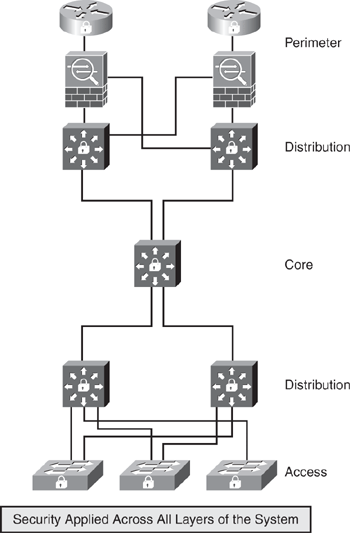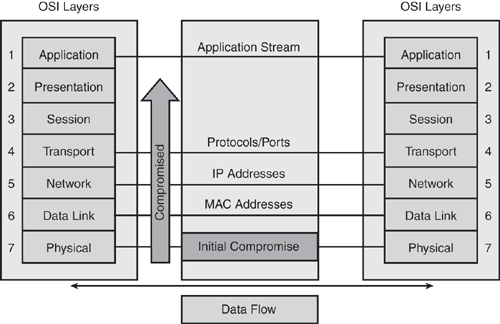As discussed earlier, security in layers is the preferred and most scalable approach to safeguard a network. One single mechanism cannot be relied on for the security of a system. To protect your infrastructure, you must apply security in layers. This layered approach is also called defense in depth. The idea is that you create multiple systems so that a failure in one does not leave you vulnerable, but is caught in the next layer. Additionally, in a layered approach, the vulnerability can be limited and contained to the affected layer because of the applied security at varying levels.
As stated previously, today's solutions are shifting toward the approach of placing safeguard mechanisms at various layers of the network, not just at the boundary or edge devices. Today, it is recommended to deploy Intrusion Prevention System (IPS) devices on both the inside and outside boundaries of private networks. Firewalls, on the other hand, are placed between various business segments or departments within the same organization, dividing the network into logical groupings and applying perimeter defense at each segment or department. In this multiperimeter model, each segment can have different layers of defense within it.
Effective perimeter security has become increasingly important over recent years. Perimeter security cannot be trusted to only the traditional defense mechanisms of firewalls and IDS. Web applications, wireless access, network interconnectivities, and VPNs have made the perimeter a much more complicated concept than it was a couple of years ago.
A layered approach requires implementing security solutions at different spectrums of the network. Another similar concept is islands of security. To implement islands of security, do not restrict your thinking to perimeter security. Do not depend on just one method for your security. You should, instead, have layers of protection—perimeter, distribution, core, and access layer. Figure 1-4 illustrates a basic multilayered security mechanism, which is designed to protect the data flow in the system.

This layered approach is related to the technology of an environment and the complexity of each of the technologies at each layer. The complexity comes from different protocols, applications, hardware, and security mechanisms that work at one or more of the seven layers in the OSI model. Just as there are different levels within an environment, different types of attacks can occur at each level and would require respective countermeasures.
The OSI reference model was built to enable different layers to work independently of each other. The layered approach was developed to accommodate changes in the evolving technology. Each OSI layer is responsible for a specific function within the networking stack, with information flowing up and down to the next subsequent layer as data is processed. Unfortunately, this means that if one layer is hacked, communications are compromised without the other layers being aware of the problem. For example, as shown in Figure 1-5, if the physical layer (Layer 1) was compromised, it could cause all other layers to be compromised in succession. Security is only as strong as the weakest link. When it comes to networking, any layer can be the weakest link.
